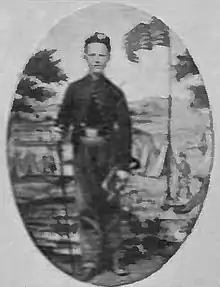John Cook | |
|---|---|
 Bugler John Cook | |
| Born | August 10, 1847 Cincinnati, Ohio |
| Died | August 3, 1915 (age 67) Washington, D.C. |
| Place of burial | |
| Allegiance | United States of America Union |
| Service/ | United States Army Union Army |
| Rank | Bugler |
| Unit | Battery Battery B, 4th Regiment U.S. Artillery |
| Battles/wars | American Civil War • Battle of Antietam • Battle of Gettysburg |
| Awards | Medal of Honor |
John Cook (August 10, 1847 – August 3, 1915) was a bugler in the Union Army during the American Civil War. At age fifteen, he earned the United States military's highest decoration, the Medal of Honor, for his actions at the Battle of Antietam.
Biography
Cook enlisted in the Union Army at age fourteen[1] in Cincinnati, Ohio, and served as a bugler in Battery B of the 4th U.S. Artillery Regiment.[2] During the Battle of Antietam on September 17, 1862,[2] his unit supported General John Gibbon's attack down the Hagerstown Turnpike.[1] Immediately after unlimbering their guns, the battery came under fire from Confederate infantrymen in the West Woods. Cook helped a wounded officer to the rear and, upon returning to his unit, found that most of the cannoneers had been killed. Seeing a dead artilleryman with a full pouch of ammunition, Cook took the pouch and began servicing the cannons. He continued to work as a cannoneer throughout the attack, despite intense fire from Confederate soldiers who came within fifteen feet of the guns.[1]
The next year, Cook participated in the Battle of Gettysburg, where he carried messages across a half-mile of fire-swept terrain. During that battle, he helped destroy a damaged caisson to prevent it from falling into the hands of approaching Confederates.[1]
For his actions at Antietam, Cook was awarded the Medal of Honor several decades later, on June 30, 1894.[2] His official Medal of Honor citation reads:
Volunteered at the age of 15 years to act as a cannoneer, and as such volunteer served a gun under a terrific fire of the enemy.[2]
Cook died at age 67 or 68, and was buried in Arlington National Cemetery, Arlington County, Virginia.[3]
See also
References
 This article incorporates public domain material from websites or documents of the United States Army Center of Military History.
This article incorporates public domain material from websites or documents of the United States Army Center of Military History.
- 1 2 3 4 Beyer, Walter F.; Oscar F. Keydel (1901). Deeds of Valor: How America's Heroes Won the Medal of Honor. Vol. 1. Detroit: The Perrien-Keydel Company. pp. 75–76.
- 1 2 3 4 "Civil War Medal of Honor recipients (A–L)". Medal of Honor citations. United States Army Center of Military History. July 16, 2007. Archived from the original on 2012-09-02. Retrieved 2009-01-23.
- ↑ Arlington National Cemetery